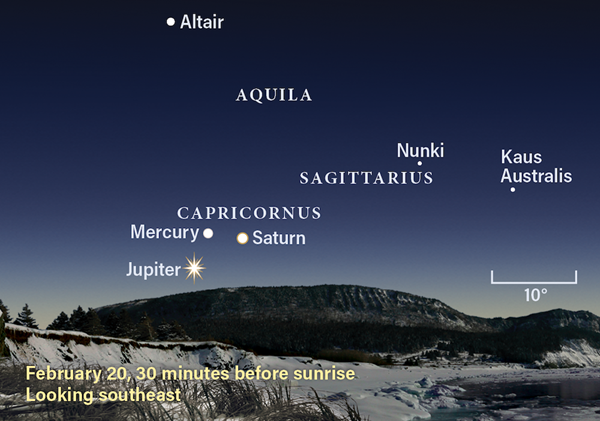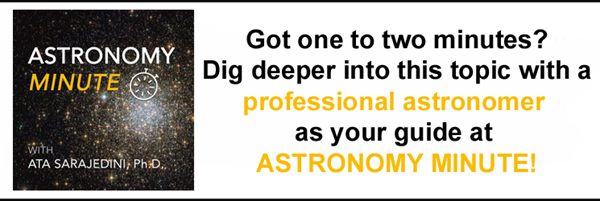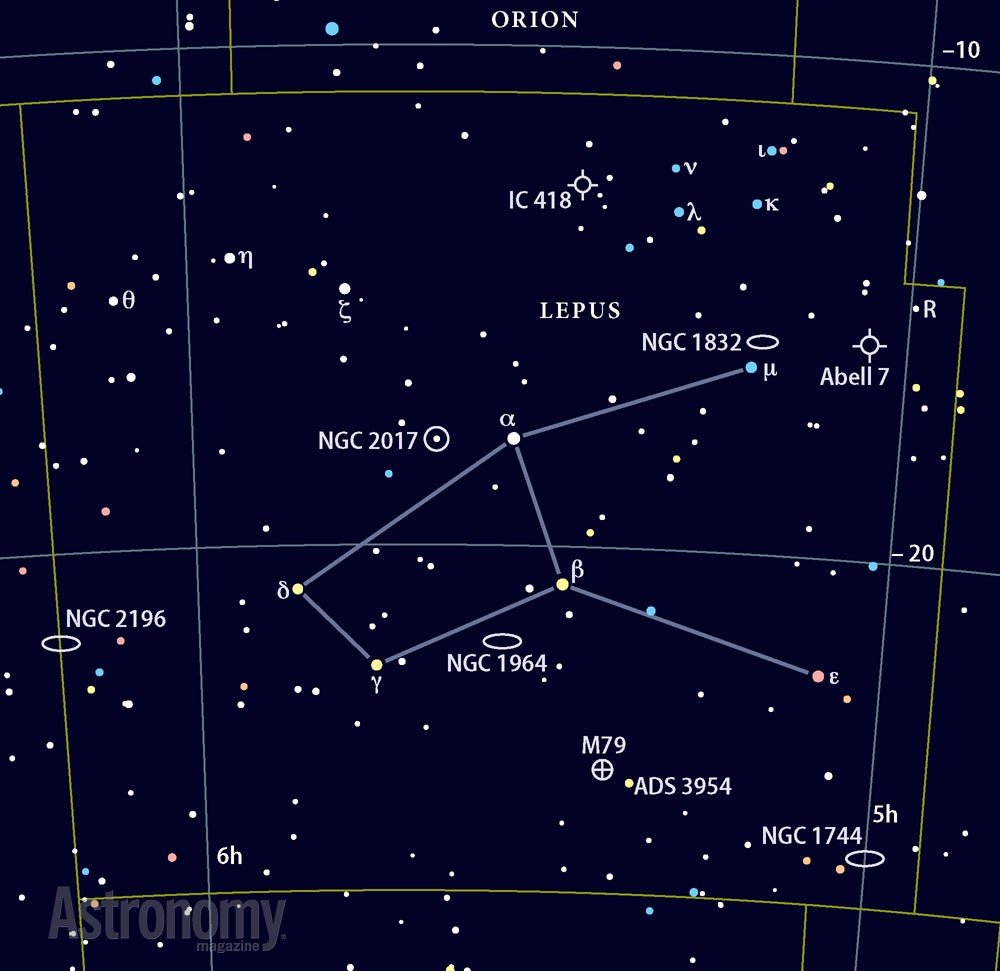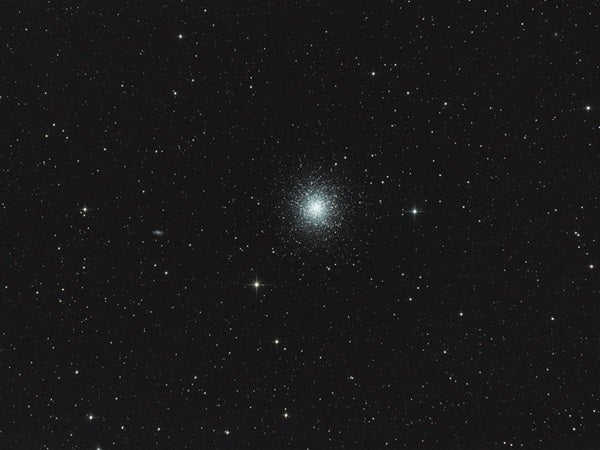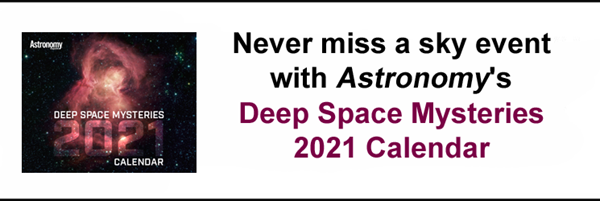First Quarter Moon occurs at 1:47 P.M. EST. The Moon is a popular observing target because it is accessible to everyone, regardless of your observing experience or equipment. Taking some time to get to know our satellite at every phase is easy, fun, and can spark your imagination as you gaze up at Earth’s constant companion.
If you do have a bit of observing experience, tonight is a great time to key in on the Moon’s northeastern limb to locate the large craters Hercules and Atlas. Nearby — closer to the lunar edge — is Mare Humboldtianum, only sometimes readily visible thanks to a phenomenon called libration. This perceived “nodding” motion of the Moon occurs not because the Moon is actually moving up and down, but because its orbit causes it to bob slightly from our point of view, allowing certain regions near the edges to roll into and out of view. Follow the Moon over the next several days to see how your view of this particular region changes as it waxes from First Quarter to Full.
Sunrise*: 6:47 A.M.
Sunset: 5:41 P.M.
Moonrise: 10:49 A.M.
Moonset: 12:36 A.M.
Moon Phase: First Quarter
*Times for sunrise, sunset, moonrise, and moonset are given in local time from 40° N 90° W. The Moon’s illumination is given at 12 P.M. local time from the same location.
Mercury is stationary at 8 A.M. EST this morning. You can catch the smallest planet just a few hours earlier as Mercury, Saturn, and Jupiter form a triangle in the early-morning sky for those willing to rise before the Sun. Saturn and Mercury rise together 4.4° apart around 5:40 A.M. local time in Capricornus, followed by Jupiter 7° east of Saturn about 22 minutes later. Mercury shines at magnitude 0.9, while Saturn is a slightly fainter 0.6. In two days, however, the planets will match in brightness exactly. Jupiter, although lower, is much brighter at magnitude –2, making it easier to spot in the brightening twilight. Keep an eye on the time and stop using optics a few minutes before sunrise in your location.
Over the next few days, Mercury will continue moving east, flattening the triangle until it meets and then overtakes Jupiter early next month.
Sunrise: 6:46 A.M.
Sunset: 5:42 P.M.
Moonrise: 11:23 A.M.
Moonset: 1:36 A.M.
Moon Phase: Waxing gibbous (59%)
Sunday, February 21
Asteroid 29 Amphitrite reaches opposition in Leo the Lion at 11 P.M. EST. Discovered in 1854, Amphitrite is one of the larger bodies in the Main Belt. Currently magnitude 9, you’ll find this 120-mile-wide (193 kilometers) world 5° east of Regulus, Leo’s brightest star. Binoculars or a small scope should show it and the later you wait, the higher Leo will rise, improving visual quality.
While you’re in Leo, scan farther east to find Chertan (Theta [θ] Leonis), then look 2.5° southeast of the magnitude 3 star to find the famous Leo Triplet of galaxies: NGC 3628, M65, and M66. These interacting spirals lie roughly 35 million light-years away and offer the opportunity to view three galaxies at the same time, all oriented at different angles with respect to Earth. M66 is the brightest at magnitude 9, while M65 and NGC 3628 are around magnitude 10. You’ll want a wide field of view (roughly 1°) to see all three at once.
Sunrise: 6:44 A.M.
Sunset: 5:44 P.M.
Moonrise: 12:03 P.M.
Moonset: 2:35 A.M.
Moon Phase: Waxing gibbous (69%)
By the time darkness falls this evening, Orion the Hunter is well above the horizon in the south. Beneath him is Lepus the Hare, a lesser-known constellation with several night-sky treasures to explore.
One is the star R Leporis, also called Hind’s Crimson Star for its discoverer, J. R. Hind. It’s located 3.5° west-northwest of magnitude 3.3 Mu (μ) Leporis. This carbon star is one of the sky’s reddest stars, colored such a vibrant ruby by a combination of its low temperature and the absorption of blue light by carbon in the star’s atmosphere. R Leporis is also a variable star, whose brightness swings over the course of a little more than a year from magnitude 5.5 at its brightest to magnitude 11.7 at its dimmest. You’ll need at least binoculars to spot it, but you’ll certainly notice once you have.
Sunrise: 6:43 A.M.
Sunset: 5:45 P.M.
Moonrise: 12:51 P.M.
Moonset: 3:34 A.M.
Moon Phase: Waxing gibbous (77%)
Tuesday, February 23
Mars slips over the border from Aries into Taurus today; this evening, you’ll find it about 5.5° southwest of the famous Pleiades star cluster (M45). Now just 7″ across (and shrinking), Mars is magnitude 0.8. That makes it roughly equal in brightness to Taurus’ alpha star, Aldebaran, which sits among (but is not part of) the Hyades open star cluster sprinkled across the Bull’s nose.
You may notice that Mars and Aldebaran are also similar in color — but their hues come from completely different sources. Aldebaran is a cool red giant star generating its own light, while Mars’ rusty red soil simply reflects light from our own Sun.
Make sure to come back to this region again and again over the next two weeks, as Mars slides south of the Pleiades and then continues its trek across the Bull for several months to come.
Sunrise: 6:41 A.M.
Sunset: 5:46 P.M.
Moonrise: 1:47 P.M.
Moonset: 4:27 A.M.
Moon Phase: Waxing gibbous (85%)
Wednesday, February 24
Let’s visit the brightest star in the Northern Hemisphere sky tonight: Sirius, also known as Alpha (α) Canis Majoris or the Dog Star.
Often depicted as the nose of Canis Major the Big Dog, Sirius’ magnitude –1.4 glow is easy to spot shortly after sunset. The star’s name itself is derived from the Greek word for “searing,” which makes sense for such a searingly bright star! Sirius is intrinsically bright (shining 26 times brighter than the Sun), but it’s so stunning in large part because it is so close to Earth — just over 8 light-years away. In fact, if you were to snag nearby magnitude 0.2 Rigel, Orion’s left knee, and pull it as close to Earth as Sirius sits, it would appear much brighter.
Finally — you may have heard of the Summer Triangle, but have you heard of the Winter Triangle? Sirius is part of this large asterism, together with Betelgeuse in Orion and Procyon in Canis Major’s fellow hunting dog, Canis Minor. You should be able to easily spot all three of these bright stars despite the waxing Moon nearby in Cancer the Crab.
Sunrise: 6:40 A.M.
Sunset: 5:47 P.M.
Moonrise: 2:50 P.M.
Moonset: 5:16 A.M.
Moon Phase: Waxing gibbous (92%)
Thursday, February 25
Cygnus the Swan, high overhead during the warm summer months, is rising before dawn these days. Two hours before sunrise this morning is a perfect time to view one of the most famous double stars in the sky: Albireo (Beta [β] Cygni). Appearing as a single magnitude 3 star to the naked eye, train some optics this way to discover it’s not one, but two stars. They are a wide 34″ apart, making them easy to split with even low-powered optics.
One of the most striking things about this system, however, is the stars’ contrasting colors. What colors do you see? Compare the cooler component — which often appears orange or red to observers — with other cool stars, such as Antares in Scorpius or Pollux in Gemini. Likewise, see how you’d rank the hotter component — which may appear blue or white — with nearby Deneb, also in Cygnus, or Vega in Lyra.
Sunrise: 6:39 A.M.
Sunset: 5:48 P.M.
Moonrise: 3:59 P.M.
Moonset: 5:59 A.M.
Moon Phase: Waxing gibbous (97%)
A nearly Full Moon makes it difficult to track down dim objects, but plenty of bright targets remain, including the Great Cluster in Hercules (M13). This massive, bright globular cluster is visible in the early morning hours before sunrise, when the Strongman is high in the East. You’ll find M13, which has a magnitude of 5.8, about 2.5° south of magnitude 3.5 Eta (η) Herculis.
This ancient group of suns spans 20′, which translates to more than 140 light-years at its distance of roughly 25,000 light-years. Famous as the best Northern Hemisphere globular cluster, M13 contains hundreds of thousands of stars. You should be able to begin resolving it at low magnification, while bumping up your aperture or magnification will show an ever-increasing number of its stars.
Sunrise: 6:37 A.M.
Sunset: 5:49 P.M.
Moonrise: 5:11 P.M.
Moonset: 6:37 A.M.
Moon Phase: Waxing gibbous (99%)

